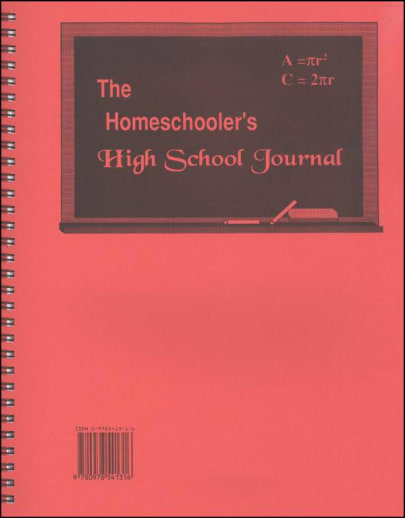High school record keeping is more important than tracking the progress of your elementary student, so the good folks that brought you the popular Homeschooler's Journal now have a high school version. As with the Journal, the bulk of the High School Journal is devoted to the weekly lesson layout. Seven columns (vs. six for the Journal) for subjects times five rows for days gives you 40 squares to work with on each pair of pages. These squares contain seven lines for writing details (as opposed to the open format of the squares in the Journal). In the lower right is a handy chart for keeping track of hours spent per subject each week, recordable in quarter-hour increments. Since the method of study (unit studies, structured text, multiple students per subject, etc.) varies from family to family, several examples show various methods of using the weekly lesson layout to your best advantage. The only other change for the High School Journal is a "Grade Record" which replaces the "Test Score Keeper" in the Journal. Daily grades can be recorded in up to 10 subjects for up to 192 days. Other miscellaneous forms in the Journal remain unchanged.
Homeschooler's High School Journal
Description
The high school version of the journal is set up a little differently than The Homeschooler's Journal. A few of the major changes were designed to document the educational progress of a single student in each of their high school years, so that these High School Journals would be their high school transcripts if they continued on to college.
The Test Score Keeper in the original was redesigned to allow for more pages to document grades within each subject, combined with a easy way to track their daily attendance if your state homeschooling laws require a certain number of days of education within a given school year to obtain a high school certification. Like the original journal there are 200 entry days which meets or exceeds most state attendance requirements.
Just like in the original each SUBJECT BOX can be changed on the fly, so that the same subject need not be taught each day. This allows for a greater number of subjects that can be documented on each lesson plan for that week. There is also an extra subject box for each day and within each subject box there are lines to assist in the recording information.
The lower right section of each five day lesson plan contains quarter hour clocks to allow for a unique way of tracking each 15 minute increment that a student spends in each subject during a five day period. (Some states require a set number of hours per subject per year for their accreditation of high school degree).
The Homeschooler's High School Journal comes in five different colors: Teal, Green, Red, Yellow, or Purple. Like the original journal the cover is still jelly proof and is wire-o-bound. The journals will lay flat on your desk or can be wrapped around onto itself. If you would like a particular color please make a note in the comment section of your order.
118Pages
Wire-O-Binding Bound
| Product Format: | Softcover Book |
|---|---|
| Grades: | 9-12 |
| Brand: | FERGNUS Services |
| ISBN: | 9780978541316 |
| Length in Inches: | 11 |
| Width in Inches: | 8.5 |
| Height in Inches: | 0.5 |
| Weight in Pounds: | 0.85 |
| Designed by: | James A. Ferguson IV |
| Publication Date: | 1997 |

